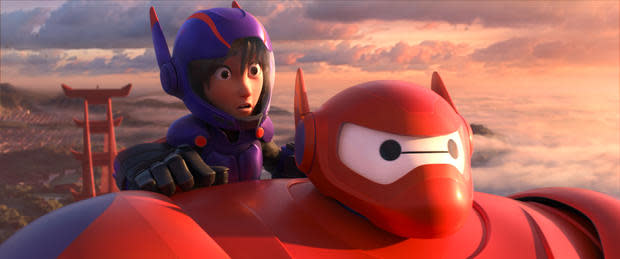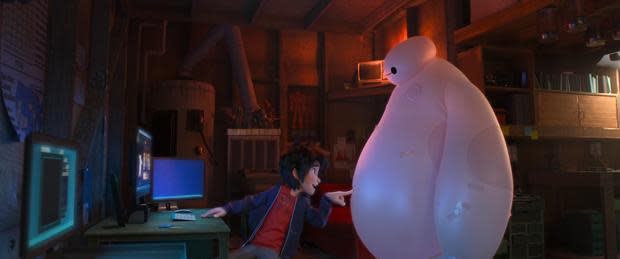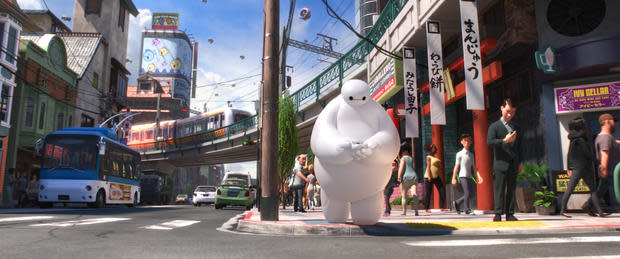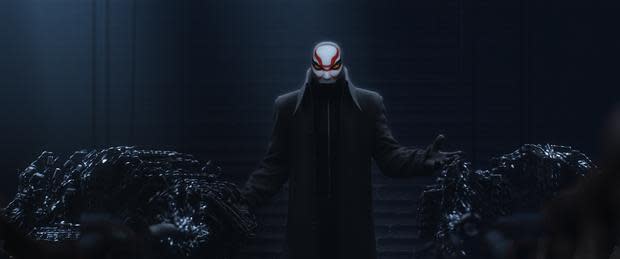Disney Animation team pushes technical boundaries with Big Hero 6

Hiro rides Baymax, the huggable robot in "Big Hero 6" wearing 3D-printed armor
Image: Disney
The real hero of "Big Hero 6" isn't Baymax, the on-screen huggable robot that has charmed audiences worldwide, but the team of artists and engineers that developed the cutting-edge technology that went into the creation of this Disney Animation megahit.
The animated film is the first ever produced with Hyperion, which is light-rendering software created by the Disney team. The software took two years and 200 million computing hours to create, and no one even knew if it would work when production began on "Big Hero 6," said Andy Hendrickson, CTO of Walt Disney Animation Studios.
"These films take about four years to make and we wrote Hyperion in about two years and used it for a good year. The first year of writing Hyperion was experiments to see if these new methods of rendering would actually work for us and how it would be idealized and optimized," Hendrickson said. "We were writing it and using it at the same time. That's not how ideally you'd want to do it. It's just like building a car while you're driving it. It's not the best way. But the idea and the visuals it was giving us on the screen were so awesome and compelling we were like, 'we've got to make this happen.'"
Hyperion is what gives "Big Hero 6" its beautiful cinematic imagery and depth. Until Hyperion was developed, Disney was never before able to use light in such a way. The light is what gives Baymax a transparent glow and allows light to bounce around inside of him, explained Don Hall, who directed the film with Chris Williams. The duo had done tests to see how audiences would react to a Baymax with a more skeletal structure visible inside him, and they found he lost a lot of his character and appeal. He needed to appear soft and glowing.

Light-rendering software gives Baymax a transparent glow.
Image: Disney
"The look I wanted for the movie from the beginning was to be very cinematic. This felt like a good opportunity to push camerawork, to push lighting to cinematic realms and as much as we could to approximate a live action camera while still maintaining our caricature," Hall said.
"We made this artistic stake in the ground: Our details will be very rich and our characters will be very simple. Luckily they had just finished Hyperion but we'd never tested it out. Everybody was very keen to give it a shot but we really didn't know if it was going to hold up to the rigors of our production schedule. This was a hard movie on all fronts. Not only did it perform but it performed beautifully," Hall said.
But to create a movie without knowing for sure if the software would work "was awe inspiring and terrifying at the same time," Hall said.
Teamwork was an essential component
Williams said, "Animation is by far the most collaborative art form there is. No one person can explain the entire process. So we all really rely on each other. We can focus on the creative side but we don't know much about the technical side and how it works."
Hall said, "We're like NASA. We're like the janitors. These guys are so smart. It reminds me of 'Apollo 13' where they're telling all the guys to duct tape the vents."
Both Hall and Williams deferred to CTO Hendrickson to explain the technical details of how Hyperion works.
Hendrickson said, "Hyperion models in the computer what rays of light do in the real world. As rays of light travel around inside the room you're in, they interact with objects and we describe accurately the interface that happens with those objects and the rays. It bounces off the object when it hits it. If it hits a diffused surface it breaks the light into hundreds, if not thousands, of lower energy rays. This bouncing goes on and on and on. Hyperion does a really good job of organizing that, the ray casting, the bouncing, over and over. It does a good job of organizing all those actions into structures that are easy for a computer to understand. We make efficient use of caches and memory. When we do that we find we can get a lot more computation out of the computer."
It took 200 million computing hours to create Hyperion because they were simulating the physics of light to illuminate each scene. "That simulation is pretty CPU intensive, as you can imagine. In each scene there are 10 billion rays of light bouncing around carrying light energy around the scenes and interacting with objects in the scene and splitting and turning into more rays of lights. That gives you kind of a softness and a depth to the shadows and the kind of lifelike highlights in the scenes you don't generally see in computer generated imagery. We're very excited about that and the proof is in the visual," Hendrickson said.
As the team experimented, they kept a Plan B on hand, which was to use the same RenderMan software from Pixar that was previously used on "Frozen" if Hyperion didn't pan out.
"For a while we were on this idea of dual paths - one like 'Frozen,' one like this - but after a while we abandoned the old style and eventually everybody threw their hands in and said, 'This is how we're going to do it. The visuals are going to be so good that we've got to make it happen.' At the time it was kind of scary. It's about taking chances for us. We like to put the maximum amount of innovation that we can on the screen that's humanly possible. That's in story, the look and the technology we use to build these worlds. All of that is considered equal innovation," Hendrickson said.
There was an immense need for processing power to produce the film. Three Disney rendering farms in Los Angeles and one in San Francisco were connected to create a supercomputer of nearly 4,600 computers running 55,000 cores. In comparison, "Frozen" used 26,000 cores. Coda, which is an automated management system, guided the information being processed from the four rendering farms.
"We do the projections by rendering a couple scenes, turning a couple of the virtual worlds into pictures, that's what we call rendering. Looking at the projections we needed this extremely large machine to do these calculations. Given the time and complexity, we needed a 55,000 core machine," Hendrickson explained.
"The energy and the cooling it takes to run such a machine doesn't exist at any one Disney site. I had to split the machine across four sites and knit it all back together into one big machine and that took quite a bit of engineering to get it all to run," he said.

Hyperion allowed the filmmakers to capture the busy look of the mythical San Fransokyo.
Image: Disney
By having a supercomputer process the images, it means that the artists can see their work the very next morning. "For the artist, they submit their work to be processed and they come in the next morning and see all the images. When we talk about the artists' submissions, they're submitting all their work to be done which oftentimes includes all the shots of all the scenes. We processed around 400,000 jobs a night. Day in and day out, seven days a week. The heavy processing was all processed in 4 or 5 months," Hendrickson said.
Technology in real life
But is the technology seen in the film possible in real life? Does microbot robotic swarm technology, for instance, exist in today's world or just onscreen? Hendrickson said this is a frequent question among those who have seen the film, where up to 20 million microbots swarm in tandem and flow over each other in circuit-like waves to create structures and shapes.

Microbot robotic swarm technology is featured in "Big Hero 6."
Image: Disney
"Microbot robotic swarm technology - what the microbots do now [onscreen] is currently not possible but then again, there's a lot of technology in movies that's currently not possible but then becomes possible. We like to think we give some inspiration. But then, microbots and swarmbots are in development now. Self-assembling robot arrays are something we definitely kept our eye on and ear to the ground. Hopefully we've set a new bar for how to make robots appealing. Just [seeing] functioning exoskeletons is not comforting. Baymax was taking the idea of the vinyl-skinned robot forward. It's an active research idea," Hendrickson said.
Among those at Disney Animation, technology is essential. "Technology is clearly not and hasn't been a sidelight. It is part of our lives and so is moving that forward and imagining what the future of technology can be. When I was a kid, flying cars and computers that did our homework was what the world was going to be and that world still hasn't come true. I think it's great that we allow ourselves to be kids and imagine what the technology could be and maybe that technology will come true," Hendrickson said.
One area of technology seen in the film was 3D printing, which obviously exists in real life, but not at the extreme level used when armor is created for Baymax. "3D printing - that's a future active topic. You'd love it to be the speed and quality and fidelity and durability that it is in 'Big Hero 6' and it will get there some day. Imagine some day kids can come home from school and dream it up and put it into a 3D CAD system and make it come true," he said.
Another technology seen in the film is mind control over robotics. Hendrickson said it "is an active research field and it's starting to yield some fruit. In the movie it's very fluid, in the real world it's not so fluid. Hopefully in the future humans will be able to interact with machines and be able to transfer their thoughts to machines. It allows the flexibility to control by using brainwaves to control the microbots." In the future, this could work when someone simply thinks about how they want to open their mail, and the robot immediately opens your email and reads it to you, he said.
"The other thing about 'Big Hero 6' that I think is fantastic is it's a world where technology is not evil. It's just there. People make it, they use it, the kids harness technology, so technology is something we use and something we use to make ourselves better rather than technology used as some sort of evil overlord. I like the positive technology message."
And the result of combining the positive message with groundbreaking light-rendering software resulted in "Big Hero 6," a film that has won over audiences worldwide since its November 7 release and has already generated $190 million in worldwide box office ticket sales.
Hendrickson said, "That's what audiences like to go see. They want to see something fresh and new and something that makes your eyeballs go wow."

